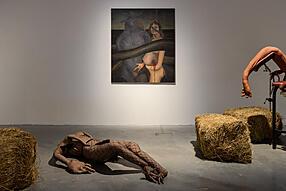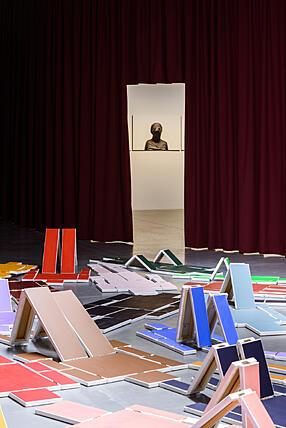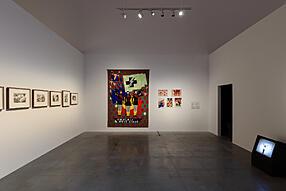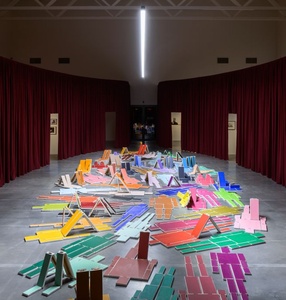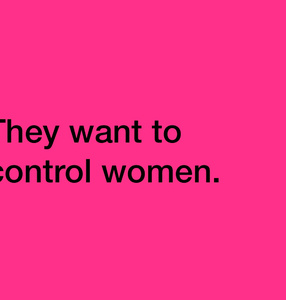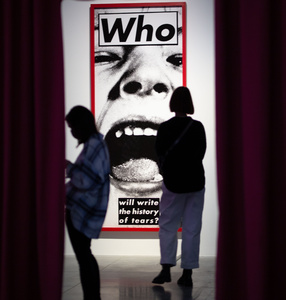Who Will Write the History of Tears
Artists on Women’s Rights
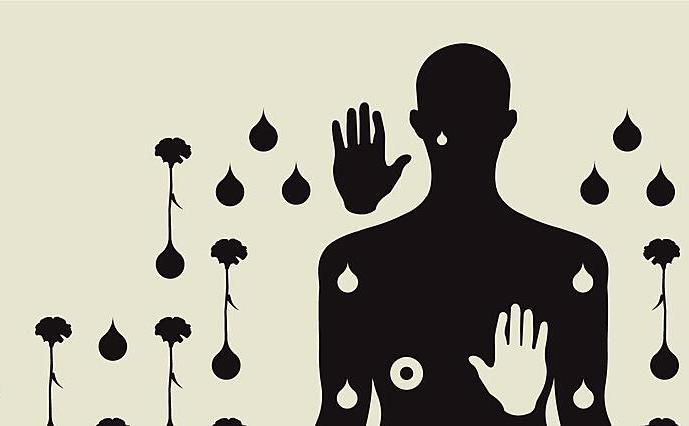
For over a century debate has raged over women’s reproductive rights. Differing visions of society and the state, the role of religion, and the limits of individual freedom clash. Who should have the deciding vote on this matter: the society, or women themselves? This issue can fundamentally divide people and provoke acts of aggression. The account of personal, individual experiences—and especially women’s perspective—is lost in the debate.
"Who Will Write the History of Tears" is an exhibition about the relations between the female body and repressive laws. The title is borrowed from a work by the American artist Barbara Kruger and underlines the arduous process of women’s pursuit of their rights. The works presented in the exhibition strive to break through the impasse that has prevailed in the debate over abortion, to transcend the crisis of verbal and visual language. The aim is to wrest the topic of abortion from the control of political clichés. The artists draw on real stories and include in their works the entire spectrum of visual and poetic allusions, images and symbols, conveying the complexity of the experience of pregnancy and abortion.
For years this concrete, human experience was taboo. Speaking of it was prohibited or frowned upon. The exhibition addresses this social denial and the existential nature of this experience. That is why we show the story of the fight for women’s reproductive rights—historical events demarcating the stages of this battle. We give voice to the participants, but also examine the theme of abortion through emotions that convey its existential and individual dimension. We can see all of this for example in the etchings by Paula Rego from 1999, Abortion Series. These scenes of suffering, abandonment and despair played a key role in the fight for reproductive rights in Portugal in 2007.
The architecture of the exhibition was created by the German architect Johanna Meyer-Grohbrügge. It alludes to the historic exhibition Womanhouse in 1972, regarded as one of the first shows of feminist art. A group of female students at the California Institute of the Arts (CalArts) renovated a house in Los Angeles slated for demolition, and, under the eye of their professors Judy Chicago and Miriam Schapiro, converted it into a surreal artistic installation, drenched in eroticism and humour, relating various spheres of women’s life. Meyer-Grohbrügge monumentalizes this domestic space, and the soft, textile architecture assumes the shape of a vagina, the “origin of the world.”
Artists
Archiwum Protestów Publicznych, Artists’ Campaign to Repeal the Eighth Amendment, Anne Maree Barry, Anna Beata Bohdziewicz, Andrea Bowers, Cecily Brennan, Tony Cokes, Cecelia Condit, Elektra KB, Rachel Fallon, Viola Głowacka, Guerrilla Girls, Patricia Hurl, Teresa Jakubowska, Anna Janczyszyn-Jaros, Maja Kleczewska & Łukasz Chotkowski, Dominika Kowynia, Barbara Kruger, Ewa Kuryluk, Alice Maher, Ana Mendieta, Fina Miralles, Mia Mullarkey, Małgorzata Mycek, Joanna Piotrowska, Luiza Prado de O. Martins, Paula Rego, Mariela Scafati, Agata Słowak, Elena Tejada-Herrera, Teresa Tyszkiewicz, Weronika Wysocka
Curatorial Team
Magda Lipska, Sebastian Cichocki, Łukasz Ronduda
Project management
Aleksandra Nasiorowska, Maria Nowakowska, Szymon Żydek
Exhibition architecture
Johanna Meyer-Grohbruegge
Key visual
Ola Jasionowska
Texts
Sebastian Cichocki, Magda Lipska, Agnieszka Graff-Osser, Maria Poprzęcka, Łukasz Ronduda, Martha Rosenberg, Katarzyna Wężyk
Translation
Arthur Barys, Zuzanna Błahuszewska, Klementyna Dec, Anna Dzierzgowska, Justyna Gardzińska, Chris Smith
Managing editor
Kacha Szaniawska
Communication
Marta Bartkowska, Józefina Bartyzel, Aleksandra Długołęcka, Anna Szałas, Aleksandra Urbańska, Iga Winczakiewicz
Public program coodrinator
Paweł Nowożycki
Film Programe Curator
Gabriela Sitek
Educational program
Marta Przybył, Marta Maliszewska,Katarzyna Benda i grupa Ponton, Jakub Depczyński, Bogna Stefańska, Petra Skarupsky, Bernard Wnuk, Cezary Wierzbicki, Dominika Jagiełło, kolektyw Blyzkist
Accessible Museum
Marta Przasnek
Conservation and restoration
Joanna Dziewanowska-Stefańczyk, Michał Kożurno
Realization
Jakub Antosz, Marek Franczak, Szymon Ignatowicz, Aleksander Kalinowski, Robert Kania, Paweł Ostromecki, Przemysław Pryciak, Paweł Sobczak, Piotr Sokół, Marcin Szubiak, Tomasz Wołkow
Graphic design of the exhibition
Monika Golisz - ALE DOBRZE STUDIO
Maciej Chodziński
Exhibition guide
historielez.artmuseum.pl/en
Webdesign
Huncwot
Cooperation
Adrian Antoniewicz, Michał Bachta, Zofia Czartoryska, Agata Górska-Campagno, Agnieszka Jędrzejczyk, Kamil Jóźwik, Andrzej Kowalski, Hubert Kowalski, Anna Nagadowska, Jarosław Paruch, Sylwia Radzikowska, Anna Ragan, Dagmara Rykalska, Eliza Sasak-Maciejczyk, Natalia Sielewicz, Olga Szeluga
Acknowledgments
Sara Buraya Boned, Cecily Brennan, Weronika Szwarc-Bronikowska, Cristea Roberts Gallery, Bożena Czubak - Fundacja Profile, Małgorzata Fuszara, Sarah Glennie, Małgorzata Charyło-Gorczyca, Łukasz Gorczyca, Magdalena Grabowska, Robert Jarosz, Bożena Keff, Hwayong Kim, Barbara Labuda, Lisette Lagnado, Tomasz Pasiek, Zdzisław Sosnowski, Ewa Dąbrowska-Szulc, Milada Ślizińska, Zenon Żyburtowicz





